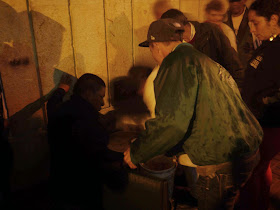 |
| A displaced man holds his son on Plaza Bolivar this evening. |
 |
| A displaced man uses a piece of cardboard as shelter from the rain on Plaza Bolivar today. |
The guerrillas "killed my father and brother and took the land for themselves," said Ligia, who fled her farm in Tolima eight years ago.
"One group arrives and demands something," recalled 78-year-old Pastor Oyuela, who was driven from his farm near Villavicencio a decade ago; "then others arrive, and if you don't give them what they want, they kill you."
 |
| Pastor Oyuela, 78, left, was driven from his land more than a decade ago. |
The terrified campesinos gather a few belongings and run, usually to cities, where they struggle to survive in these strange and frightening places.
"In the city, a campesino is lost," said Alberto, who fled his land a decade ago and has since sold empanadas and washed cars.
 |
| Displaced people huddle under plastic sheeting in the rain on Plaza Bolivar. |
 |
| A few days ago, displaced men set up another tent on Plaza Bolivar. |
Late Tuesday night police arrived on Plaza Bolivar and knocked down the tents and took away mattresses and other other belongings, which were thrown into a garbage truck, the displaced people said. Wednesday evening, under a cold rain, many of the people were still on the plaza, huddling under plastic tarps and wondering where they could go next.
When presidential election voters go to polls on Plaza Bolivar on Sunday, they won't be reminded of this huge tragedy. Presidential candidates have barely mentioned the problem of forced displacement during the campaign.
 |
| The encampment that was. |
Oyuela puts little stock in the peace talks.
"That's great that they're negotiating," he said. "But what kind of peace can there be if people are dying from hunger? If they're searching for jobs and there aren't any?"
 |
| A cross rests against a tent on Plaza Bolivar a few days ago. |
"Here we are begging for help from the government," said Oyuela, "I was never like this before."
By Mike Ceaser, of Bogotá Bike Tours
 |
| Tents and clothes hanging on Plaza Bolivar, under Garcia Marquez's portrait. |
 |
| Lining up for soup by City Hall. |
 |
| Receiving soup by City Hall. They said it was donated by neighbors. |
 |
| Dislodged people with their mattresses beside the Simon Bolivar statue on Plaza Bolivar. |
 |
| Packing up to go. |
 |
| Police watch over recently dislodged displaced people. |



Hi Mike,
ReplyDeleteMy name's Taylor, I'm currently doing research on Colombia's internally displaced and your blog posts have given me a lot of insight to the problem. Specifically I'm looking at why this issue hasn't gained more traction on a global or even local scale as you've shown in your various accounts of it. Of course the most prominent factor to take into consideration is that a majority of these people are displaced because of violence and threats of violence from paramilitary, guerrilla, and even military forces. However, I'm trying to take it a step further and understand why these people aren't given more attention and assistance once displaced. I'm specifically looking into perceptions of displaced persons within their new living environments, and trying to see if these perceptions contribute to the marginalization of the issue and the people. You've hinted at this I believe in a few of the posts I've read, for example how the government took down the tent community of protestors and city vendors (who are majorly displaced persons) are often harassed by the police while the rich are not.
I was wondering if you had any more insights that you might be willing to share? Are internally displaced persons looked down upon by the rest of their community and treated by their peers as they're treated by the government? How difficult is it for an displaced person to get a job? The government claims the number of displaced persons is in the three million range while aid organizations estimate it is in the five million range. Do you think that perceptions of displaced persons plays into this discrepancy? I know you gave one explanation for this, which is that many displaced integrate themselves into the society again quickly so that it is difficult to determine accurate estimations. But does integration mean finding a job that will provide a decent salary, or does it mean living day to day selling merchandise on the streets?
I know this is a ton of information I'm throwing out at once, but overall I just want to gain a sense of how the internally displaced are perceived by their communities. I think it could provide insight to why the problem has been continually swept under the rug for so many decades.
If you could provide me with any information I would greatly appreciate it!! You can contact me at tspicer93@ufl.edu. I also have an interview questionnaire that is going along with my research in which I am trying to determine if and to what extent non-displaced Colombians are aware of the issue. If you would like to look at it and maybe pass it along to others that would be great too!
I look forward to possibly hearing from you, and regardless your blog posts have been a great help and eye opener for me! Thanks!